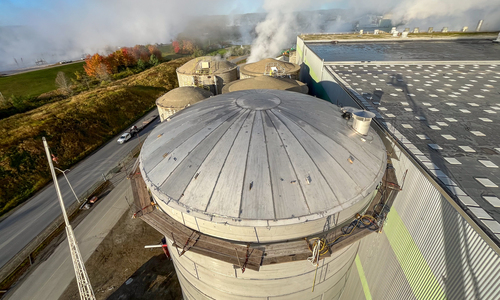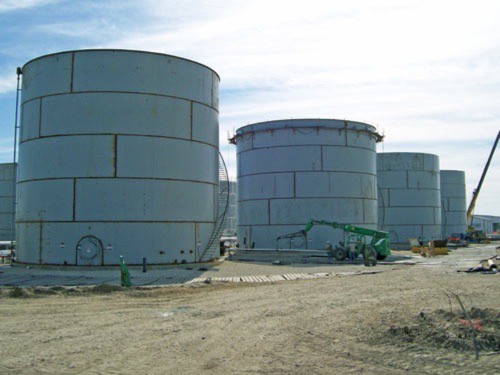All Concerning Welding Examination: Trick Perks for Your Jobs
Welding evaluation plays an important role in the building and construction and production markets. It guarantees that bonded joints fulfill high quality and safety and security criteria. By determining defects early, tasks can prevent considerable hold-ups and monetary losses. Sticking to sector guidelines not just protects the integrity of the end product yet likewise constructs depend on among stakeholders. Recognizing the nuances of this process discloses fringe benefits that can affect job outcomes substantially. What are these advantages?
Understanding the Welding Evaluation Refine
Welding is an essential component in numerous industries, the assessment procedure is essential to assure high quality and security. This procedure includes a series of methodical examinations made to determine any kind of prospective issues that might jeopardize the stability of welded joints. Inspectors review welding treatments and qualifications to confirm compliance with market criteria.
Following this, aesthetic evaluations are performed to analyze the general appearance and coating of welds. Non-destructive screening techniques, such as radiographic or ultrasonic screening, may likewise be used to spot inner imperfections without harming the product. Documents plays an important function, as it supplies a document of searchings for and examinations, validating traceability and liability.
Inevitably, comprehending the welding assessment procedure promotes confidence in the quality of the finished product, lowers the threat of failings, and improves overall project success in numerous applications, from building and construction to production. API 650 Welding Inspection.
Typical Sorts Of Welding Defects
Welding issues can substantially influence the stability and performance of bonded frameworks, as they may lead to failings under anxiety or negative conditions. Usual sorts of welding problems include splits, porosity, incomplete fusion, and slag inclusion. Cracks can create because of thermal tensions or improper air conditioning, endangering the joint's stamina. Porosity refers to the presence of gas bubbles entraped in the weld, which can compromise the joint and decrease ductility. Incomplete combination occurs when the weld steel does not correctly bond with the base material, leading to weak spots. Slag incorporation happens when non-metallic contaminations end up being entraped within the weld, causing a reduction in structural honesty. Determining these issues early with inspection is crucial for preserving top quality and guaranteeing safety and security in welded structures. Understanding these usual defects enables improved welding methods and enhanced project results.
Significance of Compliance With Industry Criteria
Compliance with sector standards is important for keeping structural integrity in welding tasks. Abiding by these requirements not just mitigates obligation dangers yet also enhances the general top quality of the ended up job. This alignment promotes depend on amongst stakeholders and warranties that projects meet both security and performance assumptions.
Guaranteeing Architectural Honesty
Assuring architectural honesty is critical in any type of building or manufacturing job, as adherence to market requirements acts as a structure for safety and security and integrity. Conformity with these criteria warranties that welding refines fulfill strenuous requirements, which is essential for the toughness of frameworks. Routine welding evaluations confirm that materials and techniques align with established guidelines, avoiding potential failings that can endanger honesty. Furthermore, complying with market standards promotes consistency in quality, which is crucial for preserving public count on construction practices. By focusing on architectural honesty with thorough adherence to requirements, organizations can boost the total efficiency of their jobs, bring about more secure settings and extended possession life expectancies. Ultimately, this commitment mirrors an aggressive technique to quality guarantee in welding methods.
Reducing Obligation Dangers
Sticking to sector requirements significantly alleviates liability risks connected with welding jobs. Compliance with developed standards assurances that welds satisfy security and efficiency standards, minimizing the probability of failings that might result in crashes or litigation. This positive strategy not just protects the workforce yet additionally safeguards the monetary interests of the business. Low quality methods or inadequate evaluations can bring about costly repair services, legal conflicts, and damages to online reputation. By executing strenuous welding inspections, companies demonstrate their dedication to top quality and safety, ultimately reducing direct exposure to possible cases. Additionally, adherence to policies strengthens trust fund amongst customers and stakeholders, as it indicates a dedication to preserving high requirements throughout the job lifecycle. Lowering responsibility risks is important for long-lasting company sustainability.
Enhancing Job High Quality
Strenuous welding examinations not just alleviate obligation dangers however also play a pivotal role in enhancing overall project top quality. By sticking to sector criteria, these examinations assure that welds satisfy specified standards for durability, toughness, and security. Compliance with developed guidelines aids determine defects early, reducing the likelihood of expensive rework or task hold-ups. Furthermore, consistent quality assurance cultivates trust amongst stakeholders, including customers and regulative bodies, which can bring about repeat organization and positive references. Inevitably, a commitment to top notch welding practices not just boosts the integrity of the final item yet likewise promotes the credibility of the company entailed. Comprehensive assessments offer as a keystone for successful and sustainable task end results.
Benefits of Early Discovery of Concerns
Early detection of welding issues uses substantial benefits, specifically regarding cost savings on fixings. By recognizing troubles prior to they rise, companies can enhance the structural integrity of their projects. This proactive approach not just decreases economic expenditures however likewise promotes security and reliability in bonded frameworks.
Expense Cost Savings on Fixes
Identifying welding concerns without delay can cause considerable expense financial savings on fixings. Early recognition of problems allows for targeted treatments, lessening the degree of damage and avoiding expensive, substantial repair work later. When problems are resolved throughout the initial stages of a task, sources are made use of a lot more effectively, decreasing both labor and product expenses. Additionally, prompt evaluations can prevent job delays, which usually incur added costs. By rectifying concerns early, companies can stay clear of the financial worry connected with rework, warranty insurance claims, and potential safety and security hazards. Inevitably, purchasing positive welding inspections promotes a much more affordable strategy to project administration, ensuring that budget plans continue to be intact while preserving the top quality and reliability of the end product.
Enhanced Architectural Honesty
Ensuring the structural honesty this contact form of bonded elements rests on the prompt identification of prospective concerns. Early discovery during the welding examination process permits for the instant correction of defects such as cracks, spaces, or inappropriate blend. Addressing these issues immediately not just boosts the strength and durability of the weld however additionally alleviates the threat of tragic failures throughout the life span of the structure. Regular evaluations contribute to a much more reliable analysis of weld top quality, making certain conformity with market criteria. By prioritizing welding assessments, project managers can preserve a greater degree of safety and performance, eventually causing successful job results. Improved structural integrity reflects the dedication to top quality and adherence to ideal techniques in welding.
Cost-Effectiveness of Welding Inspections
While several firms might check out welding assessments as an extra cost, they commonly verify to be a cost-efficient financial investment over time. By recognizing flaws early, these assessments can avoid costly repairs or replacements that might develop from undiscovered issues. This aggressive strategy not only saves cash however also decreases job delays, making certain that timelines are complied with.

In addition, top notch welding inspections add to improved effectiveness, leading to fewer rework circumstances and enhanced efficiency. The reduction in material waste and labor prices related to redesigning faulty welds adds to the economic benefits.
Investing in detailed evaluations likewise improves the total quality of the final product, which can cause raised consumer complete satisfaction and repeat organization. Inevitably, the initial expenses connected with welding inspections are usually outweighed by the long-term savings and benefits they offer, making them a sensible option for any welding job.
Enhancing Safety And Security and Integrity in Welding Projects

Welding assessments play a necessary function in improving safety and integrity within welding tasks, as they systematically identify potential threats and weak points in welds. By utilizing certified examiners, organizations can assure that welding procedures abide by sector criteria and regulative requirements. This aggressive technique reduces the threat of weld failings, which can lead to crashes, expensive repairs, and task delays.
Furthermore, inspections give vital documentation that confirms compliance and top quality assurance, cultivating depend on between stakeholders. Regular evaluations throughout different task phases enable for the prompt detection of problems, enabling restorative activities before they intensify. In addition, the insights acquired from inspections add to continual improvement in welding methods, boosting overall task end results. Eventually, durable welding inspection procedures not just shield workers but likewise guard investments, ensuring that jobs are finished successfully and meet the greatest safety and security and reliability criteria.
Regularly Asked Questions
What Certifications Should a Welding Examiner Have?
A welding examiner need to have relevant accreditations, such as Licensed Welding Examiner (CWI), in addition to extensive knowledge of welding processes, products, and codes. API 650 Welding Inspection. Experience in the area and strong logical abilities are also essential for reliable assessments
How Often Should Welding Inspections Be Conducted?
Welding examinations need to be conducted consistently, generally in the past, during, and after the welding process. The frequency might rely on job specs, regulative requirements, and the intricacy of the welds to assure structural stability and safety and security.
Can Welding Inspections Be Done Remotely?
Welding evaluations can indeed be executed from another location, making use of sophisticated technologies such as drones, cameras, and ultrasonic screening tools - API 650 Welding Inspection. This strategy enables for efficient surveillance while lessening the need for physical visibility at the website
What Equipment Are Used in Welding Inspections?
Welding examinations use various devices, including ultrasonic testers, magnetic fragment testers, visual inspection devices, radiographic equipment, and calipers. Each device offers look here a particular objective to ensure weld integrity, top quality, and conformity with industry criteria.
Exactly how Do I Pick a Welding Examination Service?

To pick a welding inspection solution, one need to examine qualifications, experience, and accreditations. In addition, evaluating customer testimonials and asking for detailed service summaries can help ensure the picked service fulfills particular task demands efficiently.
By focusing on welding inspections, task managers can preserve a greater degree of security and efficiency, ultimately leading to successful job results. Welding examinations play a vital function in enhancing security and reliability within welding projects, as they systematically recognize prospective risks and Your Domain Name weak points in welds. A welding inspector must possess relevant qualifications, such as Licensed Welding Inspector (CWI), along with comprehensive expertise of welding materials, codes, and processes. Welding assessments must be performed consistently, generally previously, throughout, and after the welding procedure. Welding examinations make use of different devices, consisting of ultrasonic testers, magnetic fragment testers, aesthetic assessment tools, radiographic devices, and calipers.